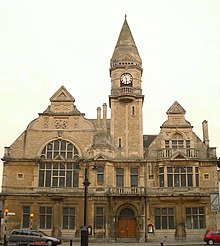Philip Dalton Hepworth
Philip Dalton Hepworth (* 1890 ; † February 21, 1963 in London ) was a British architect and landscape designer.
Life
From 1906 to 1910 he studied at the Architectural Association Schools in London and at the École des Beaux-Arts in Paris . He then became an assistant to Walter Frederick Cave and traveled through France during this time . In 1911 he completed his studies with the exam and worked for Walter Frederick Cave, Hugh Patrick Guarin Maule and William Adam Forsyth, in 1914 he received a scholarship. During the First World War he served as an officer with the pioneers . After the World War he won several awards in various competitions and received several prizes for his residential and country house designs. In the years 1920–1930 his architecture and the designs of residential houses were characterized by a high quality.
Buildings
In 1932 he designed the Walthamstow Town Hall. However, the building was not completed until 1942; The reason for this was the construction delays caused by the Second World War . In addition, he had designed Trowbridge Town Hall and a large number of residential buildings since 1932, and he continued his work in Burma . He completely restored the house he lived in by hand, replacing the facade stone by stone. From 1950 to 1952, the parish church "All Saints" near Crondall in Hampshire was restored under his leadership . From 1952 he worked for Arthur Guinness & Sons and developed inexpensive country houses for the farm workers in Bodiam ( Sussex ). Here he combined inexpensive construction with traditional design , he developed an important post-war architecture for the rural areas.
Construction management of war cemeteries
In the Second World War, now already fifty years old, he was deployed in the Home Guard, at the same time he had been appointed to the commission for the reconstruction of London. In 1944 he was appointed chief architect of what is now the Commonwealth War Graves Commission (CWGC) for north-western Europe and succeeded Sir Herbert Baker . He implemented his ideas, in his own country style, in the construction of the military cemeteries and began in Normandy. His works include the war cemeteries of Tilly-sur-Seulles , Bayeaux, La Délivrande , Jerusalem , Ranville , Banneville-La-Campagne (Canada), Beny-sur-Mer (Canadian war cemetery) and Bretteville-sur-Laize (Canadian war cemetery). He also designed the memorials in Bayeux and Dunkirk . In the Netherlands he built the Canadian war cemetery in Groesbeek and in Germany he designed the war cemeteries in Berlin (Heerstraße) , Reichswald Forest War Cemetery , Becklingen War Cemetery , Kiel War Cemetery and Rheinberg War Cemetery .
Web links
- Short biography
- Dictionary of Scottish Architects: Brief information on biography and architecture
- Commonwealth War Graves Commission: Hard and Soft Landscaping in War Cemeteries (English) (PDF 8.63 MB)
| personal data | |
|---|---|
| SURNAME | Hepworth, Philip Dalton |
| BRIEF DESCRIPTION | British architect and landscape painter |
| DATE OF BIRTH | 1890 |
| DATE OF DEATH | February 21, 1963 |
| Place of death | London |

